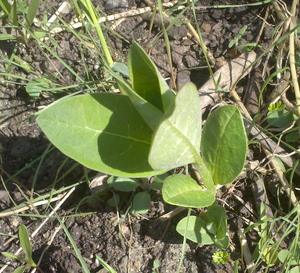Wildcrafting: milkweed for Monarchs or dinner

Milkweed shoot just past prime for eating, use caution (see article) and consider letting the plant grow in your garden for the monarch butterflies.
Linda Diane Feldt | Contributor
The stalk currently emerging in gardens all over is a thick succulent looking shoot, with the leaves starting off tight to the stem. Mine are about four to six inches high. A definitive identification is the milky white sap that bleeds from a broken or cut leaf or stem. Later, these plants are easily spotted with the ball of light purple fragrant flower clusters, and then the pods bursting with seeds that fly away to spread.
Once introduced to your garden, this plant spreads widely and easily so you will soon have plenty. First off, consider leaving it to grow. The monarch butterfly relies on milkweed for survival, laying eggs on the plant that will eventually hatch. You could even become a certified Monarch Way Station if you have a sufficient number of plants in your yard. I got the designation last year.
The monarchs are having a difficult year because of destruction of their southern habitats. If we can help them once they come north to breed, that may make a big difference. I love having them visit my garden, and they do.
Milkweed, as well as dogbane, has also been used for making natural cord or rope, after the butterflies are done with it. I have a couple of friends who gather and twist the fibers from the stalk with very sturdy and beautiful results.
If you really don’t want this plant around or can find an area where they are crowded, the stalk currently emerging is edible. There will be two later stages when it is also edible, and I’ll describe those later in the year. Almost like asparagus, you can just snap off the stalk if it is shorter than six to eight inches (a hand span) and then cook it in a few changes of water.
Now I’ve recently been told that it can be eaten just lightly steamed, but I’m going to direct you to use the change of water method just to be extra safe. The milky sap in milkweed contains toxic glycosides which are removed with water. To be safe, boil the shoots in a bit of water for two to three minutes, rinse, add new boiling water and boil another two to three minutes, rinse again, more new boiling water, boil again for two to three minutes, and then rinse and eat. The shoot will turn a very pretty bright green.
The new milk weed shoots taste fresh, a little like broccoli, and I think they have a light asparagus-like taste as well.
A few cautions: once the shoots are over six to eight inches, do not eat them. This is also true once the leaves begin to pull away form the stem. Some people may have localized dermatological reactions (irritation) from the milky sap: avoid contact with it. One of my favorite authors provides additional information on this tasty plant online.
Linda Diane Feldt is a local Holistic Health Practitioner, writer, and teacher. You can follow her on twitter, on her Web site, or e-mail ldfeldt(at)holisticwisdom.org. Her next free class sponsored by the People’s Food Co-op is on local herbs that can be used medicinally, May 27. The first weed walk of the season is Sunday May 23, from 1-3 p.m.: there is a small fee for that in-the-field class. The second walk is June 6, followed by a free weed walk sponsored by the Huron River Watershed Council on June 12.

